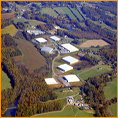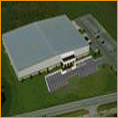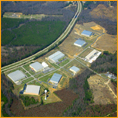Everyone knows the game. Rock beats scissors, Paper covers rock. But in the real world wouldn’t you rather have a rock than a piece of paper? Well in the real world a piece of paper called a mortgage can take your “rock” of a house, so maybe there is some wisdom in the old game. The point of the story is that things that seem to be better and stronger are not always as they appear at first glance. A pre-engineered steel building is lighter and more flexible than a hard-walled tilt-up concrete building, but which one is better?
The Hollingsworth Companies have been building and investing in industrial buildings for 30 years and we still own the first industrial building we built. So, we have lived the life-cycle of an industrial building many times over. The first industrial building we built was a pre-engineered steel building with masonry at the bottom 8 feet for better impact resistance and we have been building them that way ever since. We frequently get customers asking us, “will you build us a tilt-up concrete building?” The perception is that a tilt-up concrete building is a superior, stronger, longer lasting building. We have often priced the tilt-up concrete alternative and it varies a little, based on the cost of concrete in a particular location, but the premium for the original construction cost runs from 15%-18%. And that is just on the initial cost. The maintenance for tilt-up concrete is much higher. A tilt-up concrete building is a painted structure. A painted structure that is 40 feet tall. It is an expensive proposition to repaint the entire exterior of a tilt-up building. Repainting is actually much more expensive than the original painting because of the additional preparation work required. For a 100,000 SF building the cost to repaint every 5-7 years will be close to $50,000. A pre-engineered steel building has factory painted siding that lasts 25 years without the need for painting. Pre-engineered steel buildings are also easier to insulate to whatever level you desire, potentially saving thousands of dollars every year, for the life of the building.
But even more important over the life of an industrial building is flexibility. Tenants and processes tend to change over the life of an industrial building. Adding an intake or exhaust louver in steel siding is a very simple process and so it is easy to adapt the steel building to the changing needs of the tenant. Tilt-up concrete is a very different proposition. New openings in tilt-up panels are limited by the size and reinforcing pattern of the concrete. Additional steel framing is usually required to stabilize the cut panels. And if 5 or 10 years down the road, the opening in the panel is no longer needed, it is virtually impossible to invisibly patch the opening. With steel buildings, a new piece of siding factory painted the same as the original is readily available to restore the building to like-new condition.
The bottom line is pre-engineered buildings cost less up front, cost less to maintain and are more flexible over their useful life. That is why we stick with pre-engineered steel for our long term industrial real estate investments.



